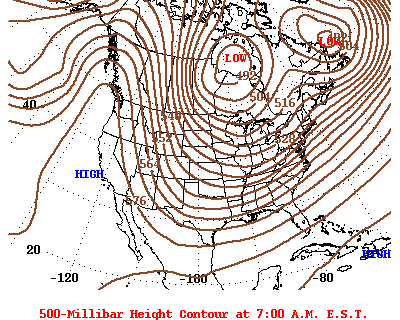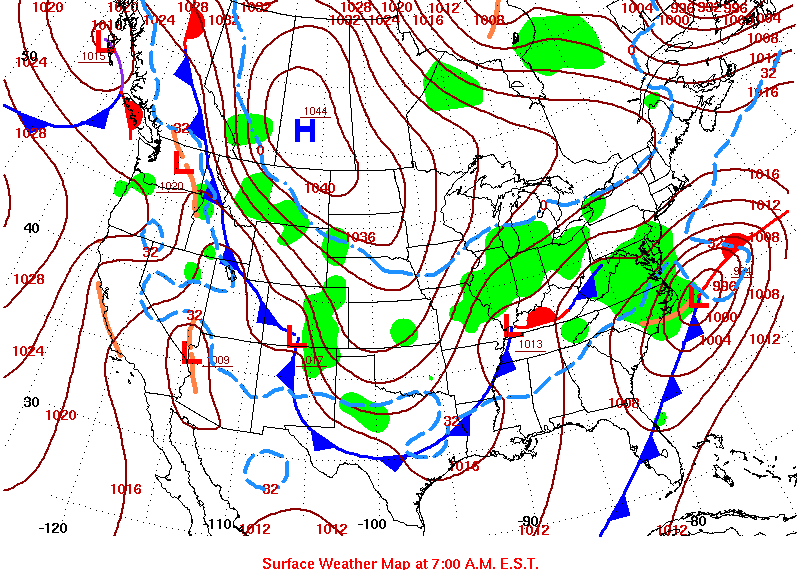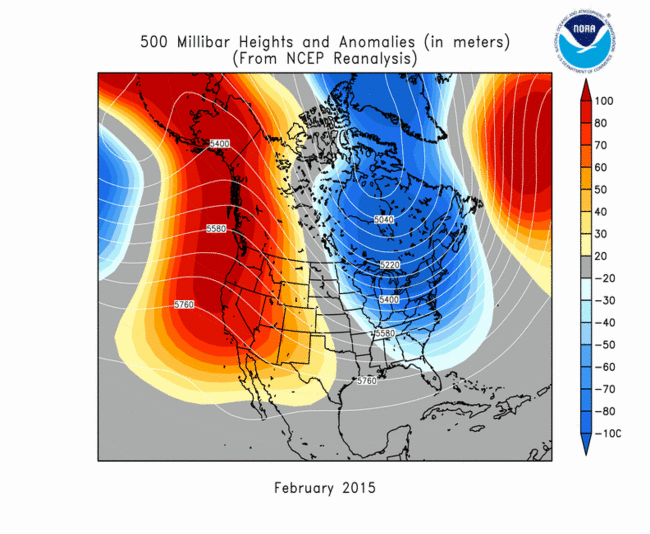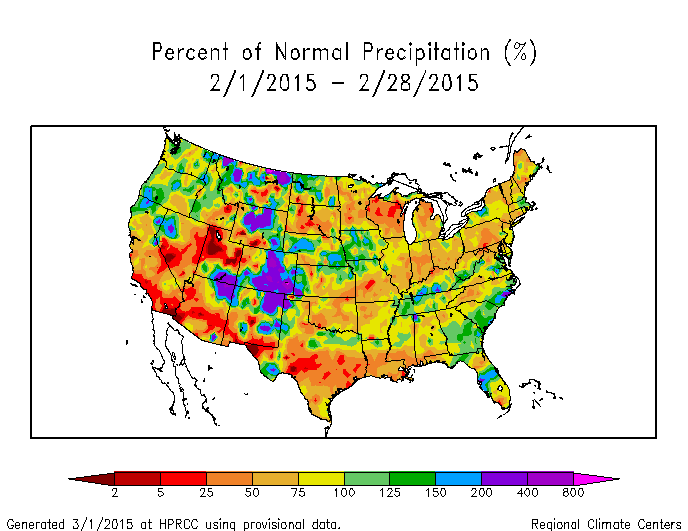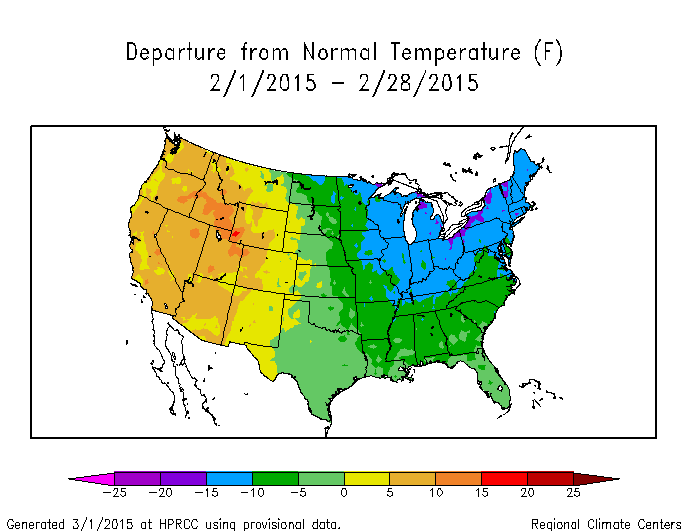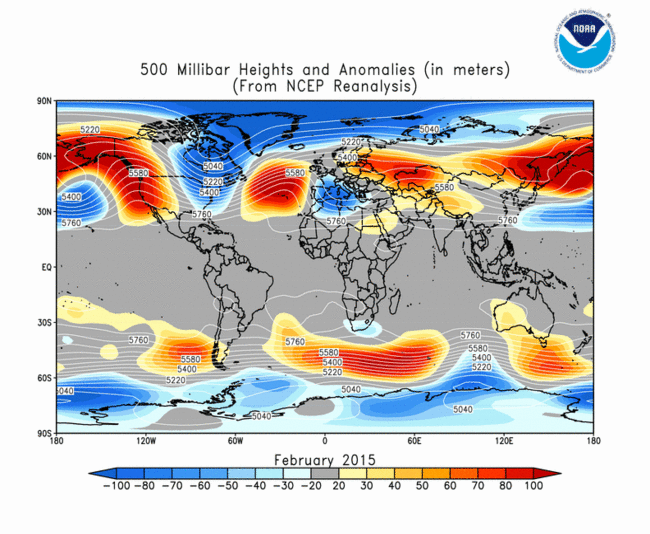Note: This Synoptic Discussion describes recent weather events and climate anomalies in relation to the phenomena that cause the weather. These phenomena include the jet stream, fronts and low pressure systems that bring precipitation, high pressure systems that bring dry weather, and the mechanisms which control these features — such as El Niño, La Niña, and other oceanic and atmospheric drivers (PNA, NAO, AO, and others). The report may contain more technical language than other components of the State of the Climate series.
Summary
February 2015 was characterized by an upper-level circulation pattern that consisted of a long-wave ridge over the western contiguous United States (CONUS) and a long-wave trough over the East. Short-wave troughs and low pressure centers moving in this flow brought areas of rain and snow to parts of the country, but the dominant long-wave circulation pattern kept much of the CONUS drier than normal with a reduced occurrence of severe weather. Several of the short-wave troughs generated winter storm systems which tapped Gulf of Mexico moisture to lay down an extensive snow cover east of the Rockies. The ridge produced record warm monthly temperatures in the West and the trough generated record to near-record cold monthly temperatures in the East. The upper-level circulation and temperature anomaly patterns suggest that the weather and climate of February 2015 were influenced very strongly by jet stream conditions over the North Pacific. See below for details.
Synoptic Discussion
|
In the Northern Hemisphere, February marks the end of climatological winter, which is the time of year when the sun angle and solar heating reach their minimum and an expanded circumpolar vortex forces the jet stream to migrate southward. In February 2015, the long-wave jet stream pattern consisted of an upper-level ridge over the western CONUS and a trough in the East. The ridge kept temperatures warmer than normal over the West, with extensive areas experiencing the warmest February in the 1895-2015 record. It also deflected most Pacific weather systems away from the drought-stricken West, resulting in many areas having a drier-than-normal month. Short-wave troughs and low pressure centers moving in the upper-level flow would ride across the top of the ridge and occasionally produce a storm system that brought precipitation, generally to the Pacific Northwest and Rocky Mountains. But the precipitation was mostly rain instead of snow, due to the well-above-normal temperatures, and contributed little toward helping the much-below-normal mountain snowpack recover, especially in the coastal ranges. The northerly flow over central North America, associated with the trough, funneled cold Canadian and Arctic air masses into the central and eastern CONUS, especially during the last half of the month. The Northeast was under seige from cold air masses throughout the month (weeks 1, 2, 3, 4). By the end of the month, there were 8,281 record cold daily high (4,778) and low (3,503) temperature records, which is one and a half times as many (5,448) record warm daily high (2,866) and low (2,582) temperature records. This was reflected in the REDTI (Residential Energy Demand Temperature Index) for February 2015, which ranked as the tenth highest February value in the 121-year record, indicating that extra energy was needed to heat homes in the heavily-populated East. The monthly average temperature ranked February 2015 as the 53rd coolest February in the 1895-2015 record, showing how the warm West mostly canceled the cold East on the national scale. |
|
The polar air masses that were pushed into the central and eastern CONUS by the upper-level northerly flow over central North America, in addition to being cold, were also dry. The circulation pattern also kept Gulf of Mexico moisture out of the Northern Plains to Upper Midwest, which were drier than normal for the month. The cold and dry circulation pattern inhibited the occurrence of severe weather, with only two tornadoes reported during February 2015, compared to a February average of 29. Low pressure systems formed along the cold fronts associated with the polar air masses, bringing a wintry mix of precipitation to the Southern and Central Plains, Midwest, South, and Northeast, expanding the CONUS snow cover area during the last half of the month. While these regions were affected by numerous winter storms, the amount of precipitation associated with them was frequently low, so only a few of these areas had normal to above-normal total precipitation for the month. The precipitation was enough to reduce the number of large wildfires, which were widespread from Oklahoma to Florida at mid-month (large wildfires on February 13, 20, and 27). The dryness in parts of the West, Plains, and Southeast resulted in an expansion of the overall national drought footprint, with 31.9 percent of the CONUS experiencing moderate to exceptional drought at the end of February, compared to 28.4 percent at the end of January. The Climate Extremes Index (CEI) aggregates temperature and precipitation extremes across space and time. The extremes in temperature created by the ridge/trough circulation pattern contributed to extreme climate as measured by the CEI. The February CEI for the U.S. ranked as the fifth highest for the month, due largely to the eighth highest cold maximum temperature component, ninth highest warm maximum temperature component, ninth highest cold minimum temperature component, and 16th highest warm minimum temperature component. The cold temperature extremes drove the regional CEI's to top ten status for two regions in the east — the Central region had the fifth most extreme February CEI in the 1910-2015 record and the Northeast region had the ninth most extreme February CEI. The West region had the most extreme February CEI on record due to extremely warm and dry conditions, while the Southwest region had the fourth most extreme February CEI due to extremely warm temperatures and an unusually high frequency of heavy one-day precipitation events. |
|
When integrated across the month, the atmospheric circulation indicated a pattern of above-normal 500-mb heights (stronger-than-normal long-wave ridge) over the western CONUS and all along the North American west coast to Alaska, extending into the North Pacific, with below-normal 500-mb heights (stronger-than-normal trough) over eastern North America extending from the eastern CONUS to Greenland. |
|
Parts of the West, Plains, and Southeast were wetter than normal during February 2015. Precipitation was below normal across much of the Southwest, Southern Plains to Central Gulf Coast, Northeast to Upper Midwest, and parts of the Northern Plains. February was drier than normal across much of Alaska and the Hawaiian Islands. |
|
February 2015 temperatures averaged warmer than normal across the western CONUS and Alaska. Temperatures were colder than normal from the Plains to the East Coast. |
Global Linkages: The upper-level circulation anomaly pattern over North America was part of a long-wave pattern that stretched across the Northern Hemisphere. Anomalous ridge/trough or trough/ridge couplets are evident over the central North Pacific/eastern North Pacific, western North America/eastern North America, eastern North America/North Atlantic, and western Europe/eastern Europe to western Asia. Positive 500-mb height anomalies dominated most of Asia. The below-normal 500-mb heights were associated with near-normal to slightly below-normal temperatures at the surface over Western Europe and northwest Africa. Eastern North America was the only region where the upper-level trough brought much below-normal temperatures. The above-normal 500-mb heights were reflected by above-normal temperatures at the surface over western North America and most of Asia. With most of the continents having warmer-than-normal temperatures, the February 2015 global temperature was well above normal.
Atmospheric Drivers
Subtropical highs, and fronts and low pressure systems moving in the mid-latitude storm track flow, are influenced by the broadscale atmospheric circulation. The circulation of the atmosphere can be analyzed and categorized into specific patterns. The Tropics, especially the equatorial Pacific Ocean, provides abundant heat energy which largely drives the world's atmospheric and oceanic circulation. The following describes several of these modes or patterns of the atmospheric circulation, their drivers, the temperature and precipitation patterns (or teleconnections) associated with them, and their index values this month:
-
El Niño Southern Oscillation (ENSO)
- Description: Oceanic and atmospheric conditions in the tropical Pacific Ocean can influence weather across the globe. ENSO is characterized by two extreme modes: El Niño (warmer-than-normal sea surface temperature [SST] anomalies in the tropical Pacific) and La Niña (cooler-than-normal SST anomalies), with the absence of either of these modes termed "ENSO-neutral" conditions.
- Status: During February 2015, weak El Niño conditions were observed as the above-average SSTs across the western and central equatorial Pacific became weakly coupled to the tropical atmosphere.
- Teleconnections (influence on weather): To the extent teleconnections are known, the typical temperature and precipitation patterns associated with El Niño during February include above-normal precipitation above the immediate Pacific, Atlantic, and Gulf of Mexico coasts, below-normal precipitation from the Southern Plains to Great Lakes and parts of the interior West, below-normal temperatures across most of the CONUS except above-normal temperatures across parts of the Pacific Northwest, Upper Michigan, and Maine.
- Comparison to Observed: The February 2015 temperature anomaly pattern shows agreement with the pattern expected with an El Niño in the Southern Plains to Southeast, but not elsewhere. Likewise, the precipitation anomaly pattern shows some agreement from the Great Lakes to Southeast, but not elsewhere. These partial agreements can be expected from the very weak nature of this month's El Niño.
-
Madden-Julian Oscillation (MJO)
- Description: The MJO is a tropical disturbance or "wave" that propagates eastward around the global tropics with a cycle on the order of 30-60 days. It is characterized by regions of enhanced and suppressed tropical rainfall. One of its indices is a phase diagram which illustrates the phase (1-8) and amplitude of the MJO on a daily basis. The MJO is categorized into eight "phases" depending on the pattern of the location and intensity of the regions of enhanced and suppressed tropical rainfall. The MJO can enter periods of little or no activity, when it becomes neutral or incoherent and has little influence on the weather. Overall, the MJO tends to be most active during ENSO-neutral years, and is often absent during moderate-to-strong El Niño and La Niña episodes.
- Status: The MJO rapidly passed through phases 6, 7, and 8 at the beginning of the month, then spent the rest of the month incoherent. The MJO indices appeared to be influenced by other modes of coherent subseasonal tropical variability, including tropical cyclone activity and Kelvin and Rossby waves (MJO updates for February 2, 9, 16, 23, and March 2).
- Teleconnections (influence on weather): The MJO's temperature and precipitation teleconnections to U.S. weather depend on time of year and MJO phase. To the extent teleconnections are known, the January-March teleconnections for temperature are shown here and for precipitation are shown here.
- Comparison to Observed: The MJO is transitory and can change phases (modes) within a month, so it is more closely related to weekly weather patterns than monthly. The February 2015 monthly temperature and precipitation anomaly patterns do not match what is expected for MJO phases 6 through 8, because the phase 6 teleconnection patterns seem to be opposite those for phase 8. There is some agreement between the weekly temperature anomaly patterns for weeks 1 and 2, and the weekly precipitation anomaly pattern for week 2, and the teleconnections expected for phase 8.
- The Pacific/North American (PNA) pattern
- Description: The PNA teleconnection pattern is associated with strong fluctuations in the strength and location of the East Asian jet stream. PNA-related blocking of the jet stream flow in the Pacific can affect weather downstream over North America, especially the West and especially in the winter half of the year.
- Status: The daily PNA index was positive for most of the month, averaging positive for the month as a whole. The 3-month-averaged index has been positive since late 2014 after a long run of mostly negative for the previous two to three years.
- Teleconnections (influence on weather): To the extent teleconnections are known, for a positive PNA, the temperature teleconnection map for this time of year (January on the teleconnection maps) shows warmer-than-normal temperatures in Alaska, western Canada, and the west coast of the U.S., and cooler-than-normal temperatures for the Southern Plains to Atlantic Coast of the CONUS. The precipitation teleconnection map shows drier-than-normal weather in the Pacific Northwest to Central Rockies and much of the country along and east of the Mississippi River. The upper-level circulation anomaly teleconnections show above-normal heights over western Canada and the western CONUS, and below-normal heights over the southeastern and eastern CONUS and much of the central to western North Pacific.
- Comparison to Observed: The February 2015 temperature and upper-level circulation anomaly patterns show some agreement with that expected with a positive PNA, although they seem to be shifted slightly. The precipitation anomaly pattern generally agrees except there are some positive precipitation anomalies mixed in with the negative.
- The Arctic Oscillation (AO) pattern
- Description: The AO teleconnection pattern relates upper-level circulation over the Arctic to circulation features over the Northern Hemisphere mid-latitudes and is most active during the cold season.
- Status: The daily AO index was mostly positive, and steadily grew more positive throughout the month, with the index averaging positive for the month. The 3-month-averaged index was positive in February, recovering from the dominance of the negative monthly values for the last several months.
- Teleconnections (influence on weather): To the extent teleconnections are known, a positive AO this time of year (January-March) is typically associated with dry conditions in the Southeast, coastal Northeast, and California, wet conditions in the Tennessee Valley and Washington coast, above-normal temperatures east of the Rocky Mountains, near normal temperatures in the West, and upper-level circulation anomalies which are below normal across the Arctic into northern North America, and above normal over the eastern CONUS, North Atlantic and North Pacific.
- Comparison to Observed: The February 2015 monthly precipitation anomaly pattern shows some similarity in the Northeast and California, but little resemblance elsewhere. The upper-level circulation anomaly pattern does not match. The temperature anomaly pattern is opposite that expected with a positive AO.
- The North Atlantic Oscillation (NAO) pattern
- Description: The NAO teleconnection pattern relates upper-level circulation over the North Atlantic Ocean to circulation features over the Northern Hemisphere mid-latitudes.
- Status: The daily NAO index was positive throughout the month, averaging positive for the month. The 3-month-averaged index was positive.
- Teleconnections (influence on weather): To the extent teleconnections are known, a positive NAO during this time of year (January on the teleconnection maps) is associated with drier-than-normal conditions in parts of the West (although the teleconnections are weak for precipitation), warmer-than-normal temperatures east of the Rockies, no temperature correlation across the West, positive upper-level circulation anomalies across the North Atlantic and most of the CONUS, and negative upper-level circulation anomalies over the Canadian Archipelago and Greenland.
- Comparison to Observed: The February 2015 precipitation anomaly pattern agrees with that for a positive NAO over the Far West (but there is little correlation elsewhere). The monthly temperature and upper-level circulation anomaly patterns are opposite those expected with a positive NAO.
- The West Pacific (WP) pattern
- Description: The WP teleconnection pattern is a primary mode of low-frequency variability over the North Pacific and reflects zonal and meridional variations in the location and intensity of the (East Asian) jet stream in the western Pacific.
- Status: The monthly WP index was negative for the month, and the three-month average WP index returned to negative territory after being negative for the last 12 to 18 months.
- Teleconnections (influence on weather): To the extent teleconnections are known, a negative WP during this time of year (January on the maps) is typically associated with above-normal temperatures in the West, below-normal temperatures in the Midwest to Northeast, drier-than-normal conditions from the Southern Plains to Midwest, and above-normal circulation anomalies over the western CONUS and above-normal circulation anomalies over the eastern CONUS to southeastern Canada (although the precipitation and circulation teleconnections are weak).
- Comparison to Observed: The February 2015 monthly temperature and upper-level circulation anomaly patterns are a close match to those expected for a negative WP over the CONUS. The precipitation anomaly pattern agrees where teleconnections exist.
- The Tropical/Northern Hemisphere (TNH) pattern
- Description: The TNH teleconnection pattern reflects large-scale changes in both the location and eastward extent of the Pacific jet stream, and also in the strength and position of the climatological mean Hudson Bay Low, and is dominant in the winter months. The pattern significantly modulates the flow of marine air into North America, as well as the southward transport of cold Canadian air into the north-central United States.
- Status: The TNH index was positive during February.
- Teleconnections (influence on weather): To the extent teleconnections are known, a positive TNH is typically associated with colder-than-normal temperatures for much of the country, drier-than-normal conditions in the West, and slightly wetter-than-normal conditions in the Tennessee Valley. The upper-level circulation anomalies for a positive TNH are below-normal 500-mb geopotential heights over the eastern two-thirds of Canada and the north central U.S., and above-normal heights over the northeastern Pacific and Gulf of Mexico into the western North Atlantic.
- Observed: The February 2015 monthly precipitation anomaly pattern has some agreement with that for a positive TNH where teleconnections exist, and the upper-level circulation anomaly pattern matches over eastern Canada but not elsewhere. The temperature anomaly pattern agrees over the central CONUS but not elsewhere.
- The East Pacific-North Pacific (EP-NP) pattern
- Description: The EP-NP teleconnection pattern relates SST and upper-level circulation patterns (geopotential height anomalies) over the eastern and northern Pacific to temperature, precipitation, and circulation anomalies downstream over North America. Its influence during the winter is not as strong as during the other three seasons.
- Status: The magnitude of the warmth of the SSTs in the northeastern North Pacific changed little this month, with the February SST pattern still showing above-normal SSTs along the North American coast and cooler-than-normal SSTs in the central to western North Pacific. The monthly EP-NP index was positive during February, keeping the 3-month running mean well in positive territory.
- Teleconnections (influence on weather): To the extent teleconnections are known, a positive EP-NP index during this time of year (April on the maps) is typically associated with colder-than-normal temperatures east of the Rockies, warmer-than-normal temperatures across the extreme West Coast and in Alaska, wetter-than-normal conditions in Wyoming and parts of the Ohio Valley (although the precipitation teleconnections are very weak), above-normal upper-level circulation anomalies (stronger upper-level ridge) over Alaska and western Canada and into the western CONUS, and below-normal upper-level circulation anomalies (stronger upper-level trough) over the northeastern CONUS and eastern Canada.
- Comparison to Observed: The February 2015 upper-level circulation anomaly pattern over North America and the North Pacific agrees very well with a positive EP-NP pattern, with the below-normal anomalies spread even further into the eastern CONUS. The February temperature anomaly pattern matches, especially east of the Rockies. The precipitation anomaly pattern shows some agreement but few teleconnections exist.
Examination of these circulation indices and their teleconnection patterns, and comparison to observed February 2015 temperature, precipitation, and circulation anomaly patterns, suggest that the weather over the CONUS in February reflected influences from the Pacific. The EP-NP and WP teleconnection indices had the strongest agreement with the February observations, with elements of the circulation anomalies matching the teleconnections for the PNA. The temperature anomaly pattern was a good match for those expected from the EP-NP and WP, although there was some agreement with the PNA and, for the first half of the month, possibly with the MJO. Precipitation correlations are weak, but for isolated areas there was some agreement between the precipitation anomalies and teleconnections for almost all of the indices.
This month illustrates how the weather and climate anomaly patterns can reflect the influence of one primary atmospheric driver (or mode of atmospheric variability), as seen in the temperature and circulation patterns, with other drivers exerting a limited influence.
 NOAA's National Centers for Environmental Information
NOAA's National Centers for Environmental Information
